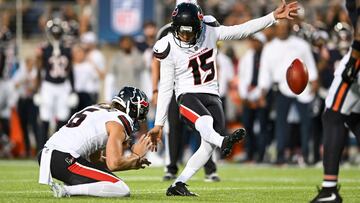How did fans react to the NFL’s new “dynamic kickoff?”
While some see it as superficial in nature, the NFL’s new rule change has sparked a variety of reactions from fans. Needless to say, not everybody is on board.


Alongside a move to clamp down on a controversial pre-snap movement, the NFL has now taken the step to implement a new form of kickoff. Whether these are the squeaky wheels in need of fixing remains to be seen, but the league certainly believes they can reduce what some see as a “cheat” motion and increase player safety respectively.
NFL’s “dynamic kickoff” introduced in Bears vs Texans Hall of Fame Game
As football fans would have seen, The NFL returned on Thursday with the Hall of Fame Game between the Chicago Bears and Houston Texans in Canton, Ohio. Now, while it was obviously a joy to have football on show once again, the true head-turner of the day was the opening kick-off as the league debuted the newly implemented “dynamic kickoff.”
For the first time... the Dynamic Kickoff 🙌
— NFL (@NFL) August 2, 2024
📺: @ProFootballHOF Game on ESPN/ABC
📱: Stream on #NFLPlus pic.twitter.com/wga0LmuvtH
For the purpose of context, it should be noted that the NFL adjusted its rules for kickoffs ahead of the 2024 season in an effort to promote player safety by reducing the high volume of injuries that occur on special teams plays. In terms of what has changed, it’s first important to know what hasn’t i.e., where the kickoff takes place. As has always been the way, the kickoff team will continue to tee up the ball at their own 35-yard-line. Once the ball is kicked, however, fans will immediately notice that there are some significant differences.
To begin with, the kickoff team is no longer permitted to start running as soon as the ball is kicked. From now on, they can only begin their run once the ball has been caught by the returner or it hits the ground. Understandably, this grants the returning team much more time to map out a formation as it attempts to bring the ball up the field. to begin to run as soon as the ball is kicked. Instead, they can only begin running down the field once the ball is caught by a returner or hits the ground. This will give the return team significantly more time to get a head of steam and organize their return formations.
Related stories
Now, this is where things get interesting. Depending on where the ball lands, is how the ‘landing zone’ is determined. As for what that term means, it refers to the new name for the area between the goal line and the 20-yard line on kickoffs. To be clear, any kick that lands short of the 20-yard line is treated in the same manner as if it were kicked out of bounds, meaning the receiving team gets possession of the ball at the 40-yard line. Kicks that land in the end zone are treated as they always were which is to say the returning team can either down the ball and take possession at the 30-yard-line or return it.
The new Dynamic Kickoff rule is going into action tonight at the @ProFootballHOF Game.
— NFL (@NFL) August 1, 2024
Before you see it, get a full breakdown of the new play, the coaches who helped shape the rules and how it was integrated into #Madden25. @EAMaddenNFL pic.twitter.com/gkRXePPpN4
As for kicks that land in the actual landing zone, the kicking team is now tasked with returning the ball. Should the ball land in the landing zone and then bounce into the end zone, the returning team can down it and receive possession at the 20-yard line. As is quite apparent, kicking teams have much more reason to try kicking as close to the goal line as possible. Lastly, if you’re wondering whether this change affects onside kicks then the answer is yes it does. From here on out, onside kicks are only permitted in the fourth quarter. Any team that wants to use an onside kick must inform the officials that it intends to do so. Also, only a team that is trailing in the game can declare for an onside kick. So, in all of this, what has the reaction of fans been? As you will see below, reviews have been mixed:
The new kickoff is going to look fake for the rest of our lives. We are gonna have to remind ourselves we are still doing that on every kickoff we see until we pass on. It won't do. I'm sorry to say we need to just go back to touchbacks.
— Kevin Clark (@bykevinclark) August 2, 2024
Feel like most special teams coordinators will hide their more creative approaches to the new kickoff during the preseason
— Mina Kimes (@minakimes) August 2, 2024
So far the new NFL kickoff is underwhelming.
— Lexi (@lexiosborne) August 2, 2024
"The NFL's not perfect. But they're always willing, unlike baseball, to change things."
— Funhouse (@BackAftaThis) August 2, 2024
Yes, I can't think of any recent rule changes in baseball.@ColinCowherd ----> 🤡 pic.twitter.com/EiTvcp52jm
First thought after the TD was “yes! we get another kickoff!”
— Mike Clay (@MikeClayNFL) August 2, 2024
So glad they fixed the kickoff 🙏 🙏🙏


Complete your personal details to comment